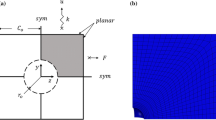Conclusions
Tolerances for the residual strain of porous solids depend strongly on the latter's nonsolidity parameter, and at 0 ~ 0 degenerate into the corresponding quantities for solid metals.
Similar content being viewed by others
Literature cited
N. N. Davidenkov, “Ludwig's flow curve,” Izv. Akad. Nauk SSSR, No. 9, 58–62 (1950).
R. J. Green, “Theory of plasticity of porous solids,” in: Mechanics: A Collection of Translations from Foreign Literature, No. 4 (1973), pp. 109–120.
S. Shima and M. Oyane, “Plasticity theory for porous metals,” Int. J. Mech. Sci.,18, No. 6, 285–291 (1976).
Author information
Authors and Affiliations
Additional information
Translated from Poroshkovaya Metallurgiya, No. 7(331), pp. 6–9, July, 1990.
Rights and permissions
About this article
Cite this article
Midukov, V.Z. Residual strain tolerances for porous solids. Powder Metall Met Ceram 29, 514–516 (1990). https://doi.org/10.1007/BF00796060
Received:
Issue Date:
DOI: https://doi.org/10.1007/BF00796060




